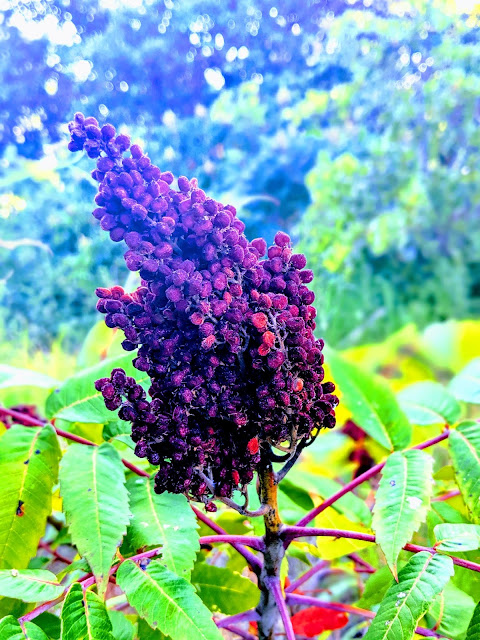Foraged Sumac
Sumac is a bright red spice extremely popular in middle eastern cooking. It's astringent without being acidic so it lends that fresh tartness without making it overly sour which means you wont need sweetener to balance it out. It's wonderful, and typically I buy it on Amazon from Spicy World. When I saw that it grew in abundance locally I decided I wanted to try foraging my own. So I went to my foraging guru, friend, and fellow blogger, Penny Price of Penniless Parenting for her tutorial on foraging your own.
Most people are familiar with sumac via the poisonous variety, but they are not the same thing. Referring again to the expert, Penny says:
"The common trait that the edible sumac plants have that distinguishes
them from poison sumac is this- edible sumac has reddish, brownish,
or purplish berries which are edible. Poison sumac's berries are white.
I bolded that and will repeat that point to make it clear- red sumac
is
edible, white sumac is poison. With that difference in mind, let us
proceed."
Yay!! So it's safe to eat for everyone? Well still not exactly, Sumac is related to the cashew family and can cause a reaction for those with nut allergies. So If you don't have a nut allergy, then yes, it's safe to eat. If you have a nut allergy then avoid sumac.
This variety, know as smooth sumac, is what grows in the midwestern US. Staghorn sumac is also common and looks similar but the berries are fuzzy. Both varieties, actually all red sumac berries, called dupes, are edible.
So once you have your sumac either from Amazon or your backyard you are going to need to know what to do with it. And that can range from the traditional to the not so traditional, seriously, who would have thought to put it with apple cake?? So I asked
Fattoush - Cilantro & Citronella
Fattoush is a middle eastern chopped salad full of all kinds of fresh and delicious chopped cucumbers, tomatoes, and pita bread in an olive oil and sumac dressing
Mediterranian Lamb Stuffed Tomatoes - Charlotte's Lively Kitchen
Tomatoes filled with delicious Mediterranean lamb flavoured with olives, lemon and herbs.
Ottolenghi's Roast Chicken with Za'atar and Sumac - Panning the Globe
Chicken thighs are spiced with za’atar and sumac, tossed with onions, lemons and garlic, and roasted.
Za'atar Spice Blend - Masala Herb
Za'atar is popular spice in the Levant full of sesame seeds, herbs, and sumac.
Spiced Apple Cinnamon Sumac Cake - Wander Cooks
Inspired by a Bulgarian dessert, this Spiced Apple Cinnamon Sumac Cake features Sumac, a tangy Middle Eastern spice alongside crunchy apples and subtle cinnamon
Lamb Kofta with Roasted Squash and Israeli Couscous - Krumpli
These lamb kofta are meatballs in all but name but are loaded with dried mint, chili and pine nuts. Served with squash roasted in pomegranate molasses and zaatar and rounded out with Israeli couscous.
Molokhia - Sunny Little Kitchen
Molokhia or Mulukhiyah is a Middle Eastern dish made with jews mallow/nalta leaves and chicken. Served over medium grain white rice, with sumac, onion, olive oil and lemon juice.
Sumac Onions - Maria Ushakova
Sumac onions is a mixture of marinated onions, the spice called sumac, and chopped parsley. It’s mostly used as a condiment to add savory flavors to meat, fish, wraps, and grain-veggie bowls.
Sumac Lemonade - Penniless Parenting
Delicious mint lemonade type drink, only not with lemon juice, but sumac juice as well.
Man'oushe - Lins Food
Lebanese street food, a popular breakfast that is eaten on the go, crispy on the outside, slightly chewy on the inside, and topped with the most aromatic of spice blends – za’atar.
Sambousek - Pandemonium Noshery
Tangy and savory Egyptian meat pastries.
Now on to how to forage your own!
1. Collect your sumac dupes. Make sure that the area you collect from is not right on a main road there they are exposed to exhaust constantly.
2. Take your dupes and separate the branches from each other to allow for airflow so they dry evenly. Allow the berries to air dry for 2 weeks, turning every few days.
3. Once the berries are dry place them in a food processor, the whole top, and process to break them up. The part is used for the spice is the shell around the berry, not the berry itself. The food processor will break up the hull but not the berries.
4. Sift the mixture through a wire strainer to separate the crushed hulls from the hard centers. Use your hand to move it around some to make sure you get all of the sumac.
5. Place in an airtight container and use on any of the above recipes or any place sumac is called for.






Comments
Post a Comment